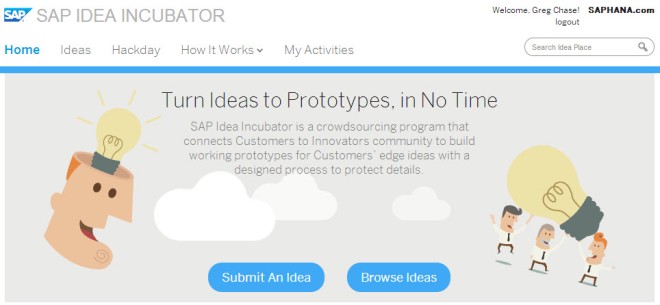
[SOURCE] Crowds gathered in a Mall in UK.
Originally posted at SAPHANA.com.
Whenever new Internet-based business models are invented, some quickly create new kinds of companies – like Amazon, Google, Facebook and Twitter. Others mature more slowly such as in the case of crowd funding and crowd sourcing. Crowd funding is finding funding for projects, products and companies from strangers on the Internet with companies such as Kickstarter, IndieGogo, and AngelList helping crowd funding mature. Crowd sourcing is sourcing work or creative ideas from strangers on the Internet with companies such as Amazon’s Mechanical Turk and 99 Designs successfully showing different models of crowd sourcing. These concepts have been around since the beginning of Web 2.0, but enterprises are still trying to understand how these might fit into their existing businesses.
Having been involved with SAP’s first crowd sourcing programs, the SAP HANA Idea Incubator, and the SAP Idea Place, I’ve run firsthand into the many different expectations that people have about these concepts. Most understand some of the benefits they might receive, but not the corresponding duties they have to making their project a success. Similarly, I think involving a crowd has some far reaching benefits that only some have set up their campaigns to fully realize.
Funding from a Crowd
Crowd funding refers to raising funds for projects or companies from strangers over the Internet.
[SOURCE] © “401(k) 2013” – used according to Creative Commons License.
So far, crowd funding has been the realm of startup projects and companies. Here are some reasons why crowd funding provides an interesting model for launching new projects and companies:
1. Raising funds for projects from a wide range of people.
Kickstarter and IndieGogo have created platforms and massive communities of people who like to fund interesting projects from local artists and small business owners. A certain amount of poverty is implied in the case of the funding requestor as they are asking people to essentially donate to their project for some reward later. These crowd-based grants provide no equity in the results of the project, nor is there any guarantee that the grantors will ever receive promised rewards.
While the general model is not suitable for projects by established enterprises with ample cash flows, there are some specific applications of this that could very well work for established companies:
2. Finding a broader array of investors for new initiatives
AngelList has been developing a platform and community that replaces what were formerly informal networks of angel investors for new startups, such as Band of Angels. This approach is gaining additional momentum thanks to the recently implemented Jobs Act in the US which relaxes the rules against advertising the availability of new venture investment opportunities to accredited investors.
This new application of crowd funding will augment and maybe disrupt the lock that venture capitalists and investment bankers had seed funding rounds, and funding of local ventures. Speculating here (I’m not qualified to provide legal interpretations of these rules), I wonder if this method of funding could be extended to allow larger companies to bring in partners to fund new ventures, or local franchises.
3. Testing market interest and reducing risk for new products
Already, we are seeing new companies use Kickstarter and IndieGoGo as a way to test market interest in new products. In fact, these tend to be among the most successful and attention grabbing of crowd funding initiatives. Essentially, the rewards people get for funding these new products is early pre-orders of the product. You get to be first, you get a discount, and you may get special limited edition versions.
I’ve seen cases where well known video game producers have been able to fund, or at least gauge that there would be significant interest in a new title produced by them. While I don’t know their personal circumstances, I would suspect that their prior success would have allowed them to find investors through traditional means. Seeding their new initiative through pre-orders reduces their risk, and allows them to negotiate better terms with traditional investors, assuming they even need them at all.
For companies considering a new venture or spin off, I think test marketing through pre-orders in this route is an acceptable exception to the “implied poverty” rule that seems to be required for traditional crowd funding campaigns. However, unlike those with “implied poverty”, you will likely have to include a money back guarantee, a significant discount, or some really compelling limited edition offers.
4. Creating a community around a product or concept
The only difference between this reason and the above is when you consider crowd funding to be a marketing campaign in addition to being a source of funding. If you bring attention and awareness to your campaign for funding, you are bringing awareness of your project or product. The question is, what will you do with these new relationships you’ve forged with your backers? Maybe they get their early release of their product and you are done. Or, maybe your greater plan includes ongoing interaction with them if your business concept includes building a massive participation community. Games such as MineCraft come to mind for me, or software development components and tools.
Sourcing from a Crowd
A collaborative community of innovation with a rich “ideas commonwealth” is the ultimate expression of a crowd sourcing program.
[SOURCE] © Steve Jurvetson, used according to Creative Commons License
Crowd sourcing refers to wide variety of interactions that let you take advantage of inexpensive or flexible work patterns, achieve a massive scale in participation, tap into creativity or ideas you don’t have access to in-house, and even go the point of creating a collaborative innovation community.
1. Commoditizing small units of work and get price and flexibility through labor arbitrage
This model is perfected by companies such as Amazon Mechanical Turk and Task Rabbit. Here, if you can accurately describe the task to be done and expected results, you can tap into a community of freelancers who will complete the tasks for you. These could be virtual “human intelligence” tasks that can be completed anywhere, or tasks that must be completed in person.
In theory, having access to a massive pool of labor would allow you to tap into a broad market price for this work. Even more useful, however, is the flexibility of finding someone fast who can complete the task, and whose expectations are to stay around as long as you need that item of work to be completed.
This model of crowdsourcing may include creative work or invention, but there are other platforms that are more specifically suited to that kind of work.
2. Achieving a massive scale of participation
It’s one thing to tap into a massive pool of labor to find a few workers, it’s another to achieve massive scale by tapping into the entire pool. So far these pools are specially built for mission to be accomplished. Flash Mobs could be an example of this from an artistic point of view. Other examples are large scale data collection and sharing by the Quantified Self movement, and people sharing their personal DNA sequences in the Personal Genome Project, or empowering populations to make reports or data collection via mobile devices.
3. Casting a wider net for ideas
Rather than finding many bodies to do physical tasks, you are tapping many minds for their imagination. Here, the platform to facilitate such work is important since not only do you want to be able to share relevant information and creative works, you need to address potential confidentiality and intellectual property ownership issues.
Another consideration is whether you create a platform to enable crowd source ideas for your core business, or to allow others to capture ideas for third party usage from a crowd of specialists. One of the best examples of inbound focused idea crowdsourcing is Procter and Gamble’s Connect and Develop program. A great example of a third party specialist crowd sourcing creativity platform is 99 Designswhich has a crowd of designers who will submit art and logo designs based on a creative briefing you submit. These kinds of idea networks have always existed, but they tended to be built and nurtured by consulting agencies.
The SAP HANA Idea Incubator is a crowdsourcing program that connects customers to experts to collaborate on creating solutions based on SAP HANA.
[SOURCE] © 2013 SAP
This is the pilot use case for the SAP HANA Idea Incubator, a crowd sourcing platform for SAP customers that allows them to submit business problems they think might be suitable for solving with a SAP HANA-based solution. Their problems are then responded to by a crowd of innovators such as data scientists statisticians, and researchers or students with experience in data mining or machine learning with who propose prototype solutions. Customers and SAP then provide grants to innovators who provide the best prototypes. The Idea Incubator platform includes important features such as ensuring managing nondisclosure and intellectual property agreements are signed, and submitting customers have designated sample datasets.
4. Creating a community of collaborative innovation
To me, the highest order benefits in crowd sourcing are derived from when you create a vibrant community of collaboration. Open source software already follows this model, and an active customer base that is encouraged to share ideas and usage will create such a community. A great example of this is the open source contributions on GitHub that Netflix makes available to other AWS customers.
An open innovation crowd sourcing program not only casts a wide net for ideas, but allows the crowd to interact and build up ideas. The ideas become commonwealth of the community themselves. A collaborative community of innovation is especially powerful for developing social innovation projects. This is among the directions I hope to eventually extend the SAP HANA Idea Incubator program.
Join the Community of Innovation around SAP HANA
Already we have several ideas in the process of collecting proposals for prototypes. Join the SAP HANA Idea Incubator community by browsing and commenting on ideas submissions or submitting your own prototype proposal or commenting on proposals and ideas, or by submitting your own idea.



[…] can be no doubt that crowd funding is a great opportunity for consumer-oriented startup companies, no matter whether they plan to stay […]